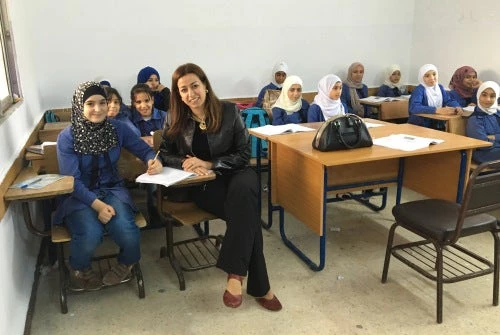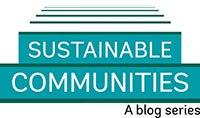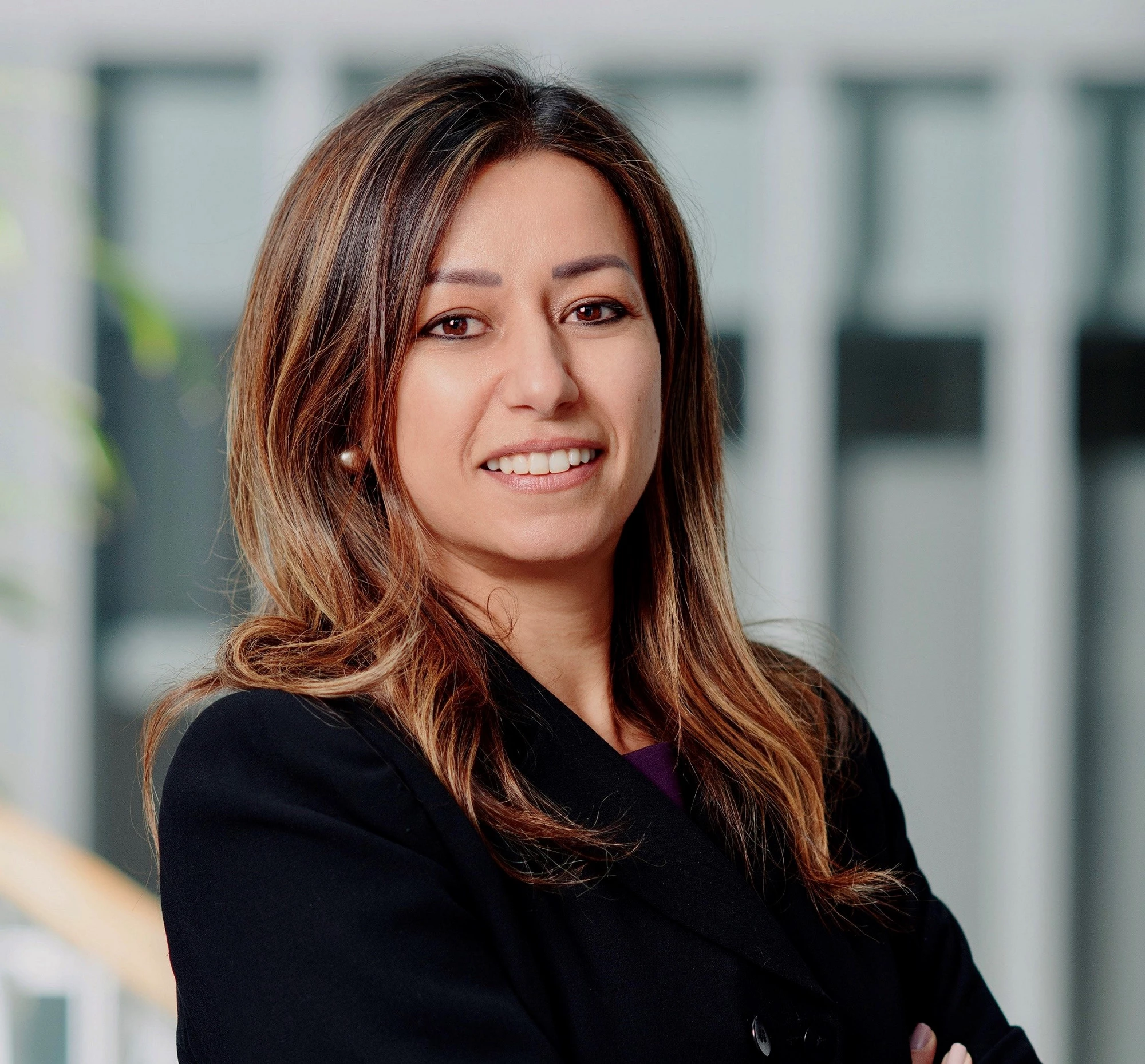The names in this article have been changed to protect the privacy of individuals.
 Nine year old Reem probably had one of the shortest distances that Syrian refugees had to travel when fleeing the crisis in their country in 2012. Her family walked 30 km from their town of Deraa --in the South-west of Syria-- to the municipality of Al Sarhan right at the border in Jordan, where they have been living since. This place is as close as it gets for a Syrian child to feel at home, with the same spoken language, environment, similar culture and traditions and oftentimes distant family relations that connect the tribes over generations. Yet, feeling at home is more than just that for Reem.
Nine year old Reem probably had one of the shortest distances that Syrian refugees had to travel when fleeing the crisis in their country in 2012. Her family walked 30 km from their town of Deraa --in the South-west of Syria-- to the municipality of Al Sarhan right at the border in Jordan, where they have been living since. This place is as close as it gets for a Syrian child to feel at home, with the same spoken language, environment, similar culture and traditions and oftentimes distant family relations that connect the tribes over generations. Yet, feeling at home is more than just that for Reem.
Her family is finding it hard to find means to support themselves, as working legally is not an option for her father who is an accountant and is trying to make ends meet by working in the informal sector. Almost all Syrian refugees who are employed in Jordan seek work in informal sectors such as agriculture, construction, food service and retail, where they are more vulnerable due to their illegal working status.
She, her two brothers and parents share a modest room that is costing them a small fortune in rent compared to their meager income and diminishing savings. Reem lost two years of schooling because the elementary school had no capacity to absorb the additional numbers of children arriving in the village.
 Nine year old Reem probably had one of the shortest distances that Syrian refugees had to travel when fleeing the crisis in their country in 2012. Her family walked 30 km from their town of Deraa --in the South-west of Syria-- to the municipality of Al Sarhan right at the border in Jordan, where they have been living since. This place is as close as it gets for a Syrian child to feel at home, with the same spoken language, environment, similar culture and traditions and oftentimes distant family relations that connect the tribes over generations. Yet, feeling at home is more than just that for Reem.
Nine year old Reem probably had one of the shortest distances that Syrian refugees had to travel when fleeing the crisis in their country in 2012. Her family walked 30 km from their town of Deraa --in the South-west of Syria-- to the municipality of Al Sarhan right at the border in Jordan, where they have been living since. This place is as close as it gets for a Syrian child to feel at home, with the same spoken language, environment, similar culture and traditions and oftentimes distant family relations that connect the tribes over generations. Yet, feeling at home is more than just that for Reem.
Her family is finding it hard to find means to support themselves, as working legally is not an option for her father who is an accountant and is trying to make ends meet by working in the informal sector. Almost all Syrian refugees who are employed in Jordan seek work in informal sectors such as agriculture, construction, food service and retail, where they are more vulnerable due to their illegal working status.
She, her two brothers and parents share a modest room that is costing them a small fortune in rent compared to their meager income and diminishing savings. Reem lost two years of schooling because the elementary school had no capacity to absorb the additional numbers of children arriving in the village.
She only started resuming her education when the Jordanian Government opened an afternoon session dedicated to Syrian children –it was at this school that I met her. Her older brother is less fortunate, he has to skip school and work in a small shop to help with the family income.
The story of Reem’s family is all too common here in Al Sarhan. A municipality of 30,000 people, Al Sarhan shares a 15 km border with Syria, and has received over 16,000 refugees, many of whom came at the first wave of exodus in 2011. Adapting his municipality to be a place where Syrian families can have decent shelter and living conditions is a daily challenge for Mr. Ali Al Sarhan, the mayor of Al Sarhan. With the added population came the excess pressure on basic infrastructure, services and facilities, the piling solid waste, and a competition for jobs against the city’s already weak ability to deliver with limited revenues, support from the State and institutional capacity.
In putting together future plans for his municipality’s services and local economic development, the mayor has to base his projections on the total number of residents including the Syrian population. The reality is many are here to stay for the medium term.
Moving from humanitarian relief to addressing the more systemic and developmental needs that face both refugees and host communities at the local level is at the core of the World Bank’s support to both Jordan and Syrian refugees. In partnership with the Governments of UK, Canada, Switzerland and Sweden, the World Bank has put in place an Emergency Services and Social Resilience Project that aims to help Jordanian municipalities and host communities in addressing the immediate service delivery impacts of Syrian refugee inflows and in strengthening the municipal capacity to support local economic development.
Over the past two years, services were reaching 1,877,000 people of whom 299,000 were Syrians, at least 45% of whom are women. Municipalities that have been participating in the project since the first year have reached their pre-crisis level of per capita investments in roads and solid waste management. An independent evaluation of interventions funded to date also confirmed that they were aligned with the communities’ priority needs with solid waste management, public roads and public lighting mentioned as the top three.
It is not only about helping local authorities and municipalities cope and adjust, but equally important to create mechanisms and implement activities that foster social cohesion among the host communities and refugees.
Historically unmet demands of the local citizens in terms of schools, recreation centers or job opportunities are now even more pertinent to avoid rising social tensions among the local communities and the Syrian refugees. And while Jordan has been one of the most welcoming countries in terms of the ability of Syrian migrants to find a place to live, the lack of economic opportunities means that conditions are getting worse for many of these families who are depleting their savings as the months goes by.
To help build bridges of trust across the two groups, support programs should think of creating shared domains, while providing support to address any social tensions, e.g. Common classrooms for children, or health training that combine women from both host communities and refugees.
Also, integrating refugees into the social fabric will create a sense of shared experience, which over time will contribute towards improved social cohesion?
Every day things get a bit easier for Reem. She is making new friends from her neighborhood, and her father has managed to partner with a Jordanian local to open a small bakery. Even though she dreams of the day she can go home to Deraa, she says: “I am happy here, I like my teachers, I am learning new things and maybe one day I can be a teacher too, so I can help my brother catch up on what he missed.”
The story of Reem’s family is all too common here in Al Sarhan. A municipality of 30,000 people, Al Sarhan shares a 15 km border with Syria, and has received over 16,000 refugees, many of whom came at the first wave of exodus in 2011. Adapting his municipality to be a place where Syrian families can have decent shelter and living conditions is a daily challenge for Mr. Ali Al Sarhan, the mayor of Al Sarhan. With the added population came the excess pressure on basic infrastructure, services and facilities, the piling solid waste, and a competition for jobs against the city’s already weak ability to deliver with limited revenues, support from the State and institutional capacity.
In putting together future plans for his municipality’s services and local economic development, the mayor has to base his projections on the total number of residents including the Syrian population. The reality is many are here to stay for the medium term.
Moving from humanitarian relief to addressing the more systemic and developmental needs that face both refugees and host communities at the local level is at the core of the World Bank’s support to both Jordan and Syrian refugees. In partnership with the Governments of UK, Canada, Switzerland and Sweden, the World Bank has put in place an Emergency Services and Social Resilience Project that aims to help Jordanian municipalities and host communities in addressing the immediate service delivery impacts of Syrian refugee inflows and in strengthening the municipal capacity to support local economic development.
Over the past two years, services were reaching 1,877,000 people of whom 299,000 were Syrians, at least 45% of whom are women. Municipalities that have been participating in the project since the first year have reached their pre-crisis level of per capita investments in roads and solid waste management. An independent evaluation of interventions funded to date also confirmed that they were aligned with the communities’ priority needs with solid waste management, public roads and public lighting mentioned as the top three.
It is not only about helping local authorities and municipalities cope and adjust, but equally important to create mechanisms and implement activities that foster social cohesion among the host communities and refugees.
Historically unmet demands of the local citizens in terms of schools, recreation centers or job opportunities are now even more pertinent to avoid rising social tensions among the local communities and the Syrian refugees. And while Jordan has been one of the most welcoming countries in terms of the ability of Syrian migrants to find a place to live, the lack of economic opportunities means that conditions are getting worse for many of these families who are depleting their savings as the months goes by.
To help build bridges of trust across the two groups, support programs should think of creating shared domains, while providing support to address any social tensions, e.g. Common classrooms for children, or health training that combine women from both host communities and refugees.
Also, integrating refugees into the social fabric will create a sense of shared experience, which over time will contribute towards improved social cohesion?
Every day things get a bit easier for Reem. She is making new friends from her neighborhood, and her father has managed to partner with a Jordanian local to open a small bakery. Even though she dreams of the day she can go home to Deraa, she says: “I am happy here, I like my teachers, I am learning new things and maybe one day I can be a teacher too, so I can help my brother catch up on what he missed.”



Join the Conversation